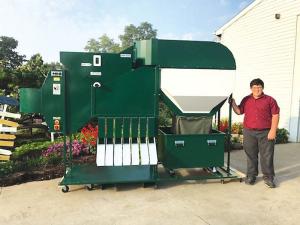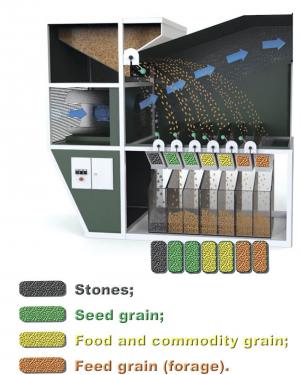Grain Separator Adds Value To Crops
DeVon Miller has found a new way to add value to grain. The Kharkov ISM (Impeller Separator Machine) separates grain into seed-quality grain, food and commodity grain, and feed grain – while also separating out stones and other debris. The machine is a step up from earlier grain cleaning machines that he has tried.
“I started out with a traditional grain cleaner for my use and for custom cleaning, but it was dusty and didn’t do what I wanted, so I sold it,” says Miller, Friendly Meadows. “After seeing a story on the WS Sosnowski Grain Cleaner in FARM SHOW (Vol. 39, No. 5), I ordered one. It worked well, and I became the U.S. distributor.”
When a Ukrainian company later contacted him about their cleaning and separating system, he checked it out. He soon added it to his farm and to his product line.
“Kharkov Grain Cleaning Equipment was the original developer of the fractionating concept,” reports Miller. “Because of weak patent protection in the Ukraine, it has been imitated since by others. However, it is still superior to them.”
The ISM comes in a variety of sizes and styles from stationary to mobile, with and without cyclone sedimentary chambers, and options. The basic operation uses airflow to separate grain and other materials by their aerodynamic properties.
“I can adjust the airflow depending on the type of grain and the end use, such as eliminating stones and splits,” says Miller. “Splits tend to plug up air streams, so eliminating splits is important for farmers with air drills wanting to replant their own seed.”
Heavy objects such as stones drop out in the first fraction. Heavier seeds drop out of the airflow in the next several fractions. As the weight drops, so does the value of the seed.
“Research has shown that the higher weight seeds have a considerably higher germination rate than lower weight seed,” says Miller. “Germination can be increased to 98 percent and yield by 30 to 40 percent.”
While the ISM can be used to clean and fractionate virtually any crop, from small grains to beans, pulses and other grains and seeds, it can also be used to fractionate mixed crops.
“There is a growing trend in some of the Great Plains states to plant multiple crops in the same field,” says Miller. “The ISM can clean and fractionate them by crop. Then the farmer can run each crop back through to fractionate by end use, such as seed for replanting, food or feed.”
ISM stationary machines are available in sizes from 5 tons per hour to 200 tons per hour. Miller carries the ISM-5, ISM-10 and ISM-20 and can order larger machines. The ISM-10 can clean and fractionate 10 tons per hour or precision-sort at 5 tons per hour. The compact machine is only 1 1/2 ft. wide by 8 ft. long by 6 ft. high.
The ISM uses a direct-flow motor with impeller for minimal airflow losses, minimal power consumption, increased machine functionality and longer service life. It is designed for minimal maintenance with no lubrication points and no spare parts needed. The ISM has adjustable shutters on the various trays to direct grain flow for even more precise fractionation.
Losses from grain diseases can be minimized or eliminated by sorting out grains damaged by mycotoxins. Miller gives the example of 10,000 bushels of wheat with 7 ppm vermitoxin having a value of $3.35 per bushel or $32,500. He compares that to running it through an ISM Grain Separator to remove 1,000 bushels of vermitoxin damaged grain, thereby reducing vermitoxin to 2 ppm in the remaining 9,000 bushels and a value of $6.50 per bushel for a total value of $58,500.
“The ISM can offer a fast return on investment,” says Miller.
Contact: FARM SHOW Followup, Friendly Meadows, 6523 Township Rd. 346, Millersburg, Ohio 44654 (ph 330 473-7647; friendlymeadows.sales@gmail.com; www.graincleanersoh.com).

Click here to download page story appeared in.
Click here to read entire issue
Grain Separator Adds Value To Crops COMBINES Miscellaneous DeVon Miller has found a new way to add value to grain The Kharkov ISM Impeller Separator Machine separates grain into seed-quality grain food and commodity grain and feed grain – while also separating out stones and other debris The machine is a step up from earlier grain cleaning machines that he has tried “I started out with a traditional grain cleaner for my use and for custom cleaning but it was dusty and didn’t do what I wanted so I sold it ” says Miller Friendly Meadows “After seeing a story on the WS Sosnowski Grain Cleaner in FARM SHOW Vol 39 No 5 I ordered one It worked well and I became the U S distributor ” When a Ukrainian company later contacted him about their cleaning and separating system he checked it out He soon added it to his farm and to his product line “Kharkov Grain Cleaning Equipment was the original developer of the fractionating concept ” reports Miller “Because of weak patent protection in the Ukraine it has been imitated since by others However it is still superior to them ” The ISM comes in a variety of sizes and styles from stationary to mobile with and without cyclone sedimentary chambers and options The basic operation uses airflow to separate grain and other materials by their aerodynamic properties “I can adjust the airflow depending on the type of grain and the end use such as eliminating stones and splits ” says Miller “Splits tend to plug up air streams so eliminating splits is important for farmers with air drills wanting to replant their own seed ” Heavy objects such as stones drop out in the first fraction Heavier seeds drop out of the airflow in the next several fractions As the weight drops so does the value of the seed “Research has shown that the higher weight seeds have a considerably higher germination rate than lower weight seed ” says Miller “Germination can be increased to 98 percent and yield by 30 to 40 percent ” While the ISM can be used to clean and fractionate virtually any crop from small grains to beans pulses and other grains and seeds it can also be used to fractionate mixed crops “There is a growing trend in some of the Great Plains states to plant multiple crops in the same field ” says Miller “The ISM can clean and fractionate them by crop Then the farmer can run each crop back through to fractionate by end use such as seed for replanting food or feed ” ISM stationary machines are available in sizes from 5 tons per hour to 200 tons per hour Miller carries the ISM-5 ISM-10 and ISM-20 and can order larger machines The ISM-10 can clean and fractionate 10 tons per hour or precision-sort at 5 tons per hour The compact machine is only 1 1/2 ft wide by 8 ft long by 6 ft high The ISM uses a direct-flow motor with impeller for minimal airflow losses minimal power consumption increased machine functionality and longer service life It is designed for minimal maintenance with no lubrication points and no spare parts needed The ISM has adjustable shutters on the various trays to direct grain flow for even more precise fractionation Losses from grain diseases can be minimized or eliminated by sorting out grains damaged by mycotoxins Miller gives the example of 10 000 bushels of wheat with 7 ppm vermitoxin having a value of $3 35 per bushel or $32 500 He compares that to running it through an ISM Grain Separator to remove 1 000 bushels of vermitoxin damaged grain thereby reducing vermitoxin to 2 ppm in the remaining 9 000 bushels and a value of $6 50 per bushel for a total value of $58 500 “The ISM can offer a fast return on investment ” says Miller Contact: FARM SHOW Followup Friendly Meadows 6523 Township Rd 346 Millersburg Ohio 44654 ph 330 473-7647; friendlymeadows sales@gmail com; www graincleanersoh com
To read the rest of this story, download this issue below or click
here to register with your account number.








